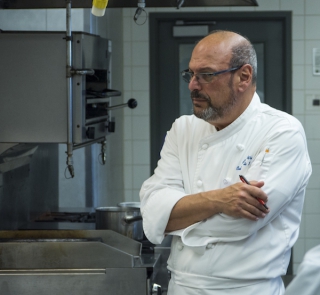
Start Small and Finish It All
07 September 2016This food waste saying – Start Small and Finish It All - was taught to my daughter when she was an outdoor education instructor between 2013 and 2014 in Occidental, Calif.
By Adam Weiner, CFSE
Earlier this year I took on the task of writing articles on how you can teach the four current hot political and social topics of food: Seafood Sustainability (February 2016), Buying Local (March 2016) and the Carbon Footprint of Food (May 2016.)
It is now time to address the issue of Food Waste. This month I will give you an introduction to the subject and write about food waste in commercial food establishments. Next month, I will write about residential food waste and give you some suggestions on teaching what can be done to avoid it.
There are over 13,000,000 hits on Google for food waste. Some of the sites claim that over 40 percent of the food produced in the United States is wasted. The subject is surprisingly controversial and not surprisingly convoluted. You cannot expect your students to master the subject in one or two class periods. However, you can expect that in time they will have a working knowledge of the issues and be sensitive to what they waste.
Let’s start with the fact that this is not really a new topic. In 1973, when I was 16 years old, my best friend Steve worked in a local pizza place. There was a sign in the kitchen that declared: “Haste Wastes Paste.” That’s where I got my first lesson on food costs.
My parents and grandparents, all of whom lived through the Great Depression, taught me from a very young age that you never waste food. When I was about 13 I asked the question, “How is me eating everything going to help the starving children in China?” My grandmother replied, “Don’t ask questions, just eat. Don’t waste food.”
What is new is the attention the subject is getting. In my opinion, this is a social issue that has been ignored for too long.
There are two perspectives that need to be taught to your students about food waste--commercial and personal. As noted above, this month I will focus on commercial food waste.
For the past 13 years, my students have been taught this from the first day: “What do you call a cook who doesn’t watch food costs? Unemployed.” Please see my twin articles Food Service Economics (November 2011) and Teaching Food Costs (December 2012.)
Waste in commercial kitchens happens for many reasons, including:
- Over ordering food creates waste. Of course, running out of food is a problem too. Many new cooks, chefs and managers tend to over order product which results in food spoilage.
- Portion sizes are too large either intentionally or inadvertently.
- The food isn’t good and thus it is not consumed.
- Customers request more than they can use. For example, many customers request second and third refills on bread and the refills don’t get eaten.
- Product is not rotated. FIFO (First In First Out) gets neglected and product spoils.
- Salad bar and buffet garnishes, such as fruit carvings, greens around the border, etc. are a waste which few think about.
Note: Even small garnishes can yield food waste. Throwing a sprig of parsley on a plate which you know won’t be eaten is just wasteful. Teach your students to garnish their food with something that will not only enhance the look of the plate, but will also be enjoyed when the guest eats it.
Not many commercial kitchens have adopted a one trash can policy. This rule states each worker is given a clear container for all of her or his compost or trash. The person may only empty it in front of the boss into the one trash can in the kitchen (usually set up outside the boss’ office). This became fashionable about 10 years ago to prevent theft (wrapping up food, small equipment, etc. throwing the things out and then later getting them out of the trash) and to minimize food costs. The latter purpose of course minimizes the waste produced in food preparation.
The hard part of this is that most of the waste in commercial kitchens is customer based. Every chef and cook knows that if they don’t watch food costs they will be unemployed. Customers wanting oversized portions (or at least ordering them thinking they want them) or not taking home and utilizing leftovers, etc. really is most of the waste in a restaurant. In food service kitchens for hospitals, universities, and corporate dining, the problem gets more complicated. People expect to see a wide variety of food which they take and don’t touch. When I catered large events, I was always astonished by how much people would take of each item on the buffet and only eat less than 25 percent of it. However, if I put out smaller plates or smaller serving trays I was always greeted with demands for more.
Next month I will cover food waste at home and how to teach ways to minimize it.
Chef Adam Weiner, CFSE, teaches a 20-week Introduction to Cooking program for JobTrain on the San Francisco Peninsula, and is a frequent presenter at CAFÉ events throughout the nation.
